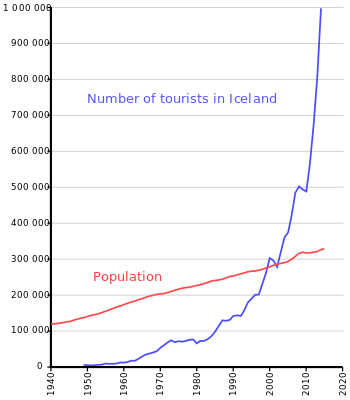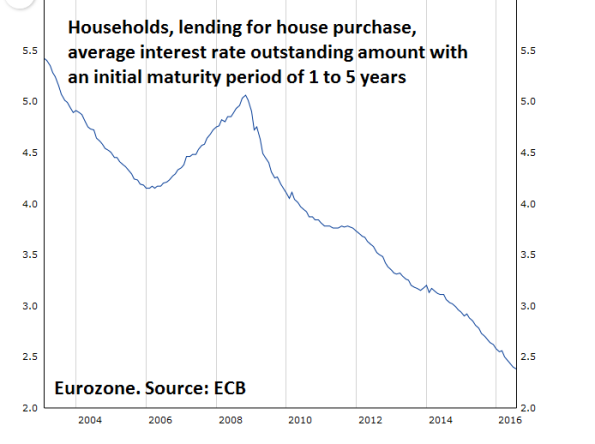Did low interest rates contribute to the growth of tourism and tehrewith to higher aggregate demand? Yes. but not like the models predict. Lower rates on existing debts (instead of on new loans) fired the animal spirits of consumers (instead of producers). In normal times, Italy would have been hailed, by EU officials, as a beacon and an example of succesful development of one of its main sectors, tourism. Nowadays, the growth of employment in Italian tourism (+10% in three years, which really is out of the old ordinary) is, in the new ordinary, only mediocre. In many countries, tourism is booming, even to the extent that the economy of entire countries, like Iceland, Estonia, Croatia, and Ireland, are bailed out, even in spite of austerity policies (Denmark is an example which shows that even extra-ordinary sectoral growth in one sector does not necessarily pull a country out of the economic mire: macro policies have to come to the rescue, too. Iceland, which has the lowest unemployment of the entire north Atlantic, is a fine example of this. It did not try to pull an austerity ‘Münchhausen‘ but enabled success by draining the bog, i.e. by writing down silly debt. But there sure also is an animal spirits, Schumpeterian side to this.
Topics:
Merijn T. Knibbe considers the following as important: Uncategorized
This could be interesting, too:
tom writes The Ukraine war and Europe’s deepening march of folly
Stavros Mavroudeas writes CfP of Marxist Macroeconomic Modelling workgroup – 18th WAPE Forum, Istanbul August 6-8, 2025
Lars Pålsson Syll writes The pretence-of-knowledge syndrome
Dean Baker writes Crypto and Donald Trump’s strategic baseball card reserve
Did low interest rates contribute to the growth of tourism and tehrewith to higher aggregate demand? Yes. but not like the models predict. Lower rates on existing debts (instead of on new loans) fired the animal spirits of consumers (instead of producers).

In normal times, Italy would have been hailed, by EU officials, as a beacon and an example of succesful development of one of its main sectors, tourism. Nowadays, the growth of employment in Italian tourism (+10% in three years, which really is out of the old ordinary) is, in the new ordinary, only mediocre. In many countries, tourism is booming, even to the extent that the economy of entire countries, like Iceland, Estonia, Croatia, and Ireland, are bailed out, even in spite of austerity policies (Denmark is an example which shows that even extra-ordinary sectoral growth in one sector does not necessarily pull a country out of the economic mire: macro policies have to come to the rescue, too. Iceland, which has the lowest unemployment of the entire north Atlantic, is a fine example of this. It did not try to pull an austerity ‘Münchhausen‘ but enabled success by draining the bog, i.e. by writing down silly debt. But there sure also is an animal spirits, Schumpeterian side to this. Overlooked by orthodox and many heterodox economists is the fact that higher aggregate demand always and necessarily also means: a different composition of aggregate demand. In this case: less finance and more tourism.
Graph 3. Source.

Which brings us to aggregate demand: is there something connected to aggregate demand policies which enables all these baby boomers to take a cruise to the ‘Blue Lagoon’ (Bláa Lónið, a quite large artificial hot lake) on Iceland? Yes, there is.
Graph 3.

Low rate policies have caused a decline of interest rate on existing debts which of course leads to lower debt service for families. Which is a very good thing. But which is not encompassed by the kind of macro models used by many economists and which only take the influence of low rate on investments into account (and even, wrongly, assume that fixed investment only consists of produced items and not of ‘land’ and other unproduced inputs…). But I have to admit: some fixed investment is produced… We can have doubts about sustainability of this all (just when you thought these baby-boomers would finally quiet down…) but maybe these boats are quite energy-efficient compared with their cars. And Bláa Lónið of course uses geothermal energy… But that’s just kidding. Sustainable living requires a lot of staying at home, eating largely vegetarian meals and walking (but not with a meat guzzling dog). And a large scale redistribution of jobs.

